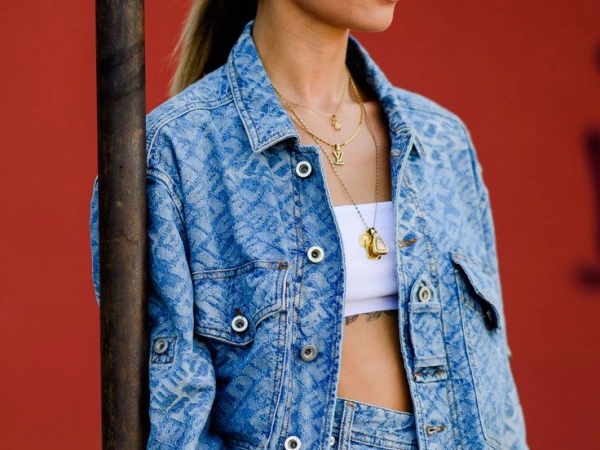Denim, a versatile and enduring fabric, has captured the hearts of fashion enthusiasts and practical-minded individuals alike. Its popularity stems from a unique combination of style, durability, and comfort. However, what sets denim apart from other fabrics, particularly cotton?
Let’s talk about from:
- Understanding Denim and Cotton
- Highlighting the Comparison between Denim and Cotton
- What Makes Denim so Strong Compared to Cotton?
- The Composition and Structure of Denim Fabric
- Factors Contributing to Denim’s Strength
- The Durability of Denim
- Comparing Denim and Cotton Strength
- Conclusion
Understanding Denim and Cotton
- Definition and characteristics of denim
Denim is a type of fabric made from sturdy cotton twill weave, typically dyed with indigo to achieve its classic blue color. It is known for its rugged texture, diagonal ribbing pattern (resulting from the twill weave), and exceptional strength. Denim’s longevity and resilience have made it synonymous with durable clothing, particularly jeans.
- Definition and characteristics of cotton
Cotton, on the other hand, is a natural fiber derived from the seed pods of the cotton plant. It is highly versatile and widely used in the textile industry due to its softness, breathability, and absorbency. Cotton fabrics are known for their comfort and suitability for a variety of garments and household items.
Highlighting the Comparison between Denim and Cotton
Denim and cotton share many similarities, but there are distinct differences that contribute to denim’s exceptional strength. To understand the superior strength of denim, we must examine factors such as fabric composition, weave, thread count, and overall structure.

What Makes Denim so Strong Compared to Cotton?
Denim’s strength is particularly noteworthy, especially when compared to cotton fabrics. This prompts the main question: What makes denim possess such impressive durability and resilience?
By delving into the composition and characteristics of denim and cotton, we can uncover the secrets behind denim’s superior strength.
As we continue with this exploration, we will analyze the unique weave of denim, the role of thread count, the quality of cotton fibers used, and the impact of indigo dye on denim’s strength. By understanding these factors, we can shed light on the reasons behind denim’s enduring reputation as a robust fabric.
The Composition and Structure of Denim Fabric
- Denim’s unique weave
Twill weave Denim fabric is characterized by its distinctive twill weave. Unlike the plain weave commonly seen in cotton fabrics, denim features a diagonal ribbing pattern. This twill weave consists of interlacing warp and weft threads, creating a strong and durable textile. The diagonal pattern in the twill weave contributes to denim’s resistance to tearing and fraying, making it ideal for clothing items that endure regular wear and tear.

- Cotton’s plain weave
In contrast to denim’s twill weave, cotton fabrics typically employ a plain weave. This weave consists of the warp and weft threads interlocking at right angles, creating a grid-like pattern. While plain woven cotton fabrics excel in breathability and comfort, they generally lack the robustness and durability found in denim.
- Role of the warp and weft in denim strength
The strength of denim can be attributed to the quality and arrangement of both the warp and weft threads. The warp threads run vertically along the length of the fabric, while the weft threads run horizontally. In denim, the warp threads are tightly woven, providing the primary strength and structure. The dense interlacing of warp and weft threads creates a sturdy foundation that contributes to denim’s overall strength and durability.
Factors Contributing to Denim’s Strength
- High thread count and tightness
Denim fabrics with a high thread count boast increased strength and durability. A higher thread count means that there are more individual warp and weft threads per square inch, resulting in a denser and sturdier fabric. Alongside thread count, the tightness of the weave also enhances denim’s strength, as tightly woven threads provide greater resistance to stress and strain.
- Use of double warp and weft threads
To further reinforce denim’s strength, manufacturers often incorporate double warp and weft threads. By doubling the number of threads in both the warp and weft directions, the fabric becomes even more resilient. The additional threads increase the fabric’s tensile strength, making it less susceptible to tearing and unraveling.
- Cotton fiber quality in denim production
The quality of the cotton fibers used in denim production is another determining factor in denim’s strength. Denim manufacturers prioritize the use of longer cotton fibers, known as long-staple or extra-long staple cotton. These fibers possess superior strength and can be tightly spun into yarns that contribute to the robustness of the fabric. Moreover, the longer fibers result in fewer loose ends, reducing the likelihood of fraying or breakage.
- The role of indigo dye in strengthening denim
Indigo dye, traditionally used to color denim, serves a dual purpose in strengthening the fabric. First, the dye penetrates the fiber, adding an extra layer of protection against external forces. Additionally, the dye’s chemical composition can alter the structure of the cotton fibers, increasing their resistance and durability. As a result, indigo-dyed denim exhibits enhanced strength and longevity.
The Durability of Denim
- Denim’s resistance to tearing and abrasion
One of the key attributes that make denim a durable fabric is its remarkable resistance to tearing and abrasion. The tightly woven twill construction of denim, combined with its high thread count and double warp and weft threads, imparts a remarkable level of strength. This makes denim ideal for garments and products that experience frequent use and demanding conditions.

- Examples of durable denim products
Denim’s durability lends itself well to a wide range of products, especially those requiring resilience and longevity. Jeans, perhaps the most iconic denim garment, are designed to withstand the rigors of daily wear and tear. The robustness of denim also makes it an excellent choice for workwear, such as overalls, jackets, and utility pants. These garments provide not only style but also the necessary durability for people in labor-intensive industries.
Comparing Denim and Cotton Strength
- Cotton’s strength limitations
While cotton has its own set of advantages, it falls short in terms of strength when compared to denim. Cotton’s tear strength and durability are relatively lower due to its plain weave and less dense thread count. This makes cotton fabrics more susceptible to fraying, tearing, and wearing out over time. Despite these limitations, cotton remains highly favored for its breathability and softness, particularly in warm weather or for lightweight clothing items.
- Cotton’s advantages
Cotton, known for its natural properties, offers superior breathability, ensuring comfort in hot and humid conditions. Its softness against the skin is another cherished attribute, making cotton an excellent choice for garments that prioritize comfort and gentle touch. These features make cotton fabrics ideal for daily wear, casual clothing, and various lightweight applications.
Conclusion
In conclusion, denim’s superior strength compared to cotton can be attributed to several key factors. The unique twill weave, high thread count, utilization of double warp and weft threads, the quality of cotton fibers used, and the incorporation of indigo dye all contribute to the exceptional durability of denim. This strength grants denim the ability to withstand tearing and abrasion, making it a reliable choice for durable clothing items and products.
As we’ve explored the factors that make denim stronger than cotton, we must also acknowledge the unique advantages that cotton possesses. With its breathability and softness, cotton remains a popular choice for lightweight and comfortable garments. Each fabric has its strengths and qualities, catering to different needs and preferences.





